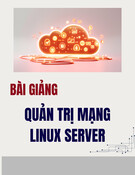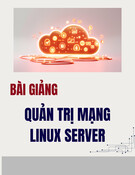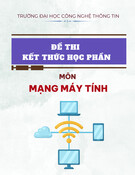
Index 303
LAN port 186
MAN port 186
RS:
RS-232 189, 239
RS-485 189
Satellites 255–61
advanced communications technology
satellite (ACTS) 255
advantages, satellite networks 258–9
applications, satellite systems 259
bulk information broadcasting 260
full-duplex-based protocol 264
GEO satellites 256
geo synchronous earth orbit (GEO) 255
geostationary earth orbit (GEO) 256
GLOBALSTAR 256
information retrieval 260
IRIDIUM 256
LEO satellites 256
methods of optimizing, TCP/IP over
satellite channels 266
avoidance techniques 267
congestion avoidance 267
large window extension (TCP-LW) 266–
7
random early detection (RED) 267
selective acknowledgment (TCP-SACK)
266
MobileLEO 256
point-to-multi-point link 255
remote control and login 259
satellite-to-satellite linking 256
spoofing 267
telecommunications 256
three-way handshake 264, 266
very small aperture terminal (VSAT) 255
video conferencing 259
Security considerations 216
6-bit pseudo-random code 219
access control lists (ACLs) 220
authentication 219, 229
hackers 216–8
information security policies 225–6
network security policies 233
network-sniffing device 217
PIN number 219
secure ID tag 219
security advisory services 226
security breaches 218
Servers:
embedded web servers 237
network time servers 190
print servers 188
first-come first-served basis 188
serial and parallel printers 188
remote access servers 189
global positioning system (GPS) 190
PPP or SLIP 189
Radius, Kerberos or secureID 189
stand-alone devices 190
terminal servers 188
connect multiple 188
serial devices 188
thin servers 189, 239, 242
DIN rail package 189
Ethernet LANs 239
port redirector 189
signal-channel terminal servers 189
thin server applications 239
universal thin servers 239
Session layer 26, 29
network connection 26
Shannon, formula 7
Shannon-Hartley law 7
Simple mail transfer protocol (SMTP) 77,
133, 154
client 155
data command 155
processes 154
quit command 155
server 154–5
SMTP commands 155
TELNET connection 155, 195
Simple network management protocol
(SNMP) 150–1, 153–4, 176, 210–1, 220,
241
basic commands 151
basic components 151
GetBulk operation 153
GetNest operation 153
Inform operation 153
interoperability 154
protocol data unit (PDU) 154
proxy agents 154
management information base (MIB) 151
hierarchy 152
object 151
standards organizations 152

304 Index
network-management systems (NMSs)
151–4
set operation 153
SNMP security 153
masquerading 153
modification of information 153
security threats 153
trap operation 153
Simplex 8
transmission 8
Sockets 124, 131
Stop bit 10
Supervisory control and data acquisition
(SCADA) 234, 241–2
Ethernet compatible SCADA systems 241
factory automation systems 236
java-based SCADA 241
stand-alone SCADA systems 234
TCP/IP based factory automation 242
TCP/IP Ethernet-based systems 234–5
web compatible SCADA systems 242
Switches 182–3, 236, 238, 251
cut-through vs store-and-forward 183
packet destination address 183
packet errors 183
full-duplex switches 183
Ethernet NIC 183
full-duplex Ethernet 183
layer 2 switches vs layer 3 switches 183
data link layer 183, 186
node to switch 65
non-buffered switches 70
switch applications 183
standard Ethernet/IEEE 802.3 185
VLAN ID number 186
VLANs and deterministic Ethernet 185
switch-to-switch, full-duplex 65
Synchronous 3, 11, 14, 31, 33
data frame 14
synchronous data link control (SDLC) 3
synchronous optic network (SONET) 33
transmission 11
block 11
post-amble 11
TCP/IP 30, 74–5, 80, 91, 116–7, 107, 133,
146, 149–50, 154, 158–59, 167, 170–1, 186,
191, 201, 203, 205, 207, 216, 220, 222, 224,
234–7, 241, 244, 246, 249–50, 255, 258–61,
263, 265–67
host-to-host layer 76, 122
initial sequence number (ISN) 124, 129
IP and TCP headers 128
major drawback 131
non-connection-oriented protocol 131
PHS bit 128
positive acknowledgment 125–6
pseudo-random sequence number 127
sequence number 124–5, 127
sliding window 125–6
streaming audio 131
streaming video 131
synchronization parameters 131
TCP connection phase 126
unreliable protocol 131
satellite see Satellite
simple mail transfer protocol see Simple
mail transfer protocol
system components 174
modern network devices 175
TCP/IP protocol suite Vs ARPA model 75
firmware 75
network interface layer 75
serial line internet protocol (SLIP) 76
switched multimegabit data service
(SMDS) 76
TCP/IP stack 77
troubleshooting see Troubleshooting
user data protocol see User data protocol
user datagram protocol (UDP) 131
Telecommunications network (TELNET) 77,
134, 136, 140–3, 154–5, 195, 205, 220
carriage-return character 140
concurrent connections 140
IAC-IP (or 255-244) 141
interpret as command (IAC) 141
network virtual terminal (NVT) 140
Token 40
active monitor (AM) 41
data packet see Packet
network architectures 41
node to node 40–1
probabilistic access method 41
standby monitors (SMs) 41
token ring network 41
Topology 33–4, 41, 115, 177–8
broadcast point-to-point topologies 33
broadcast topologies 33
bus topology 35, 39, 41
advantages 35

Index 305
disadvantages 35
point-to-point system 35, 37
component topologies 35
hybrid topologies 35
logical and physical topologies 34–6
logical bus topology 48
media-access methods 34
mesh topology 39
network topologies 33
nodes see Node
physical topology 48
point-to-point topologies 34
ring topology 36, 37
advantages 37
disadvantages 37
star topology 36, 39, 49
advantages 36
disadvantages 36
star-wired ring topology 38
advantages 38
disadvantages 38
multistation access units (MAUs) 38
tree topology 39
advantages 39
daisy-chained 39
disadvantages 39
distributed bus 39
hybrid physical topology 39
Transmitter 2–3, 8, 18
to convert 2
Transport layer 26
distributed star topology 38
outgoing packets 26
protocols see Protocols
subnet layers 26
subnet service classes 26
upper layer 26
utilities see Utilities
Troubleshooting 249–50
bridges or switches 251
CPU utilization 250
CRC/alignments 250
CSMA/CD Ethernet system 251
disk I/O 250
errors/second 250
Ethernet card 251
frame check sequence (FCS) 251
jabbers 250
kilobytes/second 249
memory usage 250
network congestion 253
ping command 253
packets/second 249
percentage utilization 249
with TCP/IP utilities 251
hardware problems 253
intermittent problems 253
netstat-i 253
queue field 253
spray command 253
Unconfirmed connection oriented service
(UOS) 31
UNIX operating systems 140
User data protocol (UDP) 76, 96, 122, 131–2,
137, 156, 137–8, 150, 159, 167, 264–5
checksum procedure 132
datagram 131
frame format 131
pseudo header 132
zero transmitted checksum 132
Utilities:
DOS ping command 165
HOSTS file 173
windows hosts file 173
ICMP echo 162
IPCONFIG 168
host 168, 172–3
multi-homes host 168
PCMCIA 168
PPP adapter 168
NBTSTAT 167
netstat options 167
protocol statistics 167
packet internet groper (ping) 162
ping utility 163
ROUTE 172
time to live (TTL) 164
TJPingPro 165, 171
TRACE Rou Te 170
user-friendliest option 171
WINIPCFG 169
windows IP configuration 169
Virtual private network (VPN) 20
encryption techniques 20
packet switched links 20
Wide area network 17–20, 30, 120, 163, 186,
188, 202–4, 212

306 Index
WINS 149–50, 158
IP address mapping 149
name registration 150
name resolution 150
client 150
database 150
proxy agents 150
TCP/IP configuration 149, 168
WINS server 149
World wide web 193, 196–7, 212–3, 266

![Câu hỏi trắc nghiệm Mạng máy tính: Tổng hợp [mới nhất]](https://cdn.tailieu.vn/images/document/thumbnail/2025/20251001/kimphuong1001/135x160/15231759305303.jpg)







![Giáo trình Triển khai hệ thống mạng Trường Cao đẳng nghề Số 20 [Mới nhất]](https://cdn.tailieu.vn/images/document/thumbnail/2024/20240830/xuanphongdacy04/135x160/177320125.jpg)











![Đề thi cuối kì Nhập môn Mạng máy tính: Tổng hợp [Năm]](https://cdn.tailieu.vn/images/document/thumbnail/2025/20251110/nminhthoi53@gmail.com/135x160/38281762757217.jpg)



![Đề thi học kì 2 môn Nhập môn Mạng máy tính [kèm đáp án]](https://cdn.tailieu.vn/images/document/thumbnail/2025/20251014/lakim0906/135x160/23811760416180.jpg)
